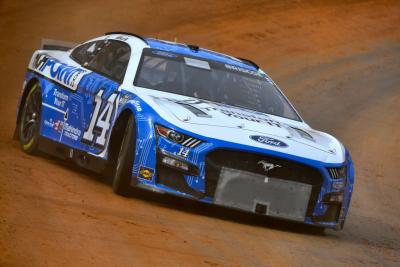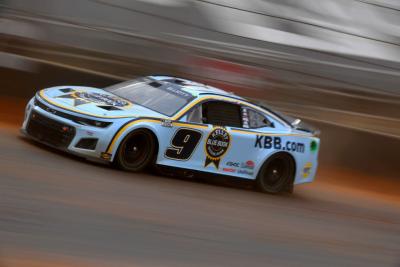Drivers Challenged in Friday Practice on Bristol Dirt
The Cup Series will race at a short-track for the third consecutive weekend on Sunday. After two very different races in Virginia, things are about to take a wild twist.
Bristol Motor Speedway has always been one of the most popular venues on the NASCAR schedule, and for good reason. The view is exceptional, the on-track product always delivers, and the post-race fireworks never disappoint. Last year it was decided that the track would cover the entire surface with dirt, and a new tradition would be born.
Beneath the surface of the red clay that coats the 0.533-mile track sits two inches of sawdust. The top layer is Bluff City Red Tennessee Clay, which is what will be all over these Next Gen cars all weekend. In addition to this race being on dirt, it is special for another reason. This is the first time since 1989 that NASCAR will have a race on Easter Sunday.
Of course, the format used for this weekend will be different as well. There were two 50-minute practice sessions today, the only event scheduled to have two practices this season. Instead of single-car or group qualifying, teams will battle through four 15-lap heat races tomorrow night to ultimately determine starting positions for the race on Sunday night.
Tyler Reddick paced the opening practice session with a lap of 89.924 mph in his No. 8 Richard Childress Racing Chevrolet. Hendrick Motorsports seemed to have their hands full in the session, with Alex Bowman spinning just two minutes in, and Chase Elliott spinning his No. 9 Chevrolet three times in less than 45 minutes. Chase Briscoe suffered a flat left-rear tire and Denny Hamlin scraped the outside wall. Ross Chastain, Joey Logano, and Justin Haley all spun during the session as well.
Hamlin went even faster during the second session on Friday evening. The Joe Gibbs Racing driver had a speed of 87.218 mph, which was slightly faster than his teammate Kyle Busch. Seven drivers made some level of contact with the outside wall in the second session, and Elliott spun yet again.
All 36 chartered teams are entered, so nine cars will compete in each heat. At the end of each heat, drivers will be awarded both finishing points and passing points. Finishing points will be awarded just like stage points. Drivers will also accumulate passing points, gaining one point per position gained from their initial starting position. No points will be deducted for positions lost. Combined point totals will then determine the starting lineup for the 250-lap feature event.
In addition to all of the changes on the cars themselves, Goodyear also had to make some tweaks to their tires from last year. They developed a special 15-inch bias ply tire for the inaugural event last season but will be using an 18-inch radial tire this weekend. Greg Stucker, the Director of Racing for Goodyear explained the changes they made.
“We felt the right move was for a radial tire, which provides a greater degree of size consistency. However, a radial tire incorporates a much stiffer tread surface, so we made adjustments to the tire construction to achieve a more compliant feel, similar to that of a bias ply, and able to handle the irregularities of a dirt surface. The 18-inch package also includes a new tread pattern, which incorporates a lot of dirt tire technology we’ve developed over the years, and tread compounds adjusted to be more resistant to heat and wear.”
The changes to the tires and just having the Next Gen car in general should help the drivers this weekend. Those with experience racing on dirt should still hold an advantage over the rest of the field, but Logano won this event last year without any previous experience.
Oddly enough, Logano has not won a points-paying race since. The former Cup Series champion is on a 37-race winless streak, which is his longest winless streak since joining Team Penske. His teammate Ryan Blaney is working on a much more positive streak. The driver of the No. 12 Ford Mustang is the first driver since Tony Stewart in 2006 to lead in each of the first eight races of a season.
This race has also shifted from day time to a race under the lights, which should help drivers like Elliott. “I think it’s a great thing moving this event to night,” Elliott said. “I think it’s going to help a lot with the issues we had, keeping some moisture in the track, hopefully, and then obviously keeping the dust down. I think everything we learned last year has been a great tool of how to go about it this season. It seems like we’re doing all the right things, and hopefully it will be a good show. I think it has a lot of potential.”
One other interesting wrinkle comes on Sunday. The race will still be a 125-mile even broken up into three stages, but things will change on pit road. Outside of stage breaks, teams are not allowed to fuel their cars or change tires. They can work on their cars under caution but have to restart behind the non-pitting cars. During the stage breaks, teams are given the option to pit. No driver can gain or lose position on pit road at this time. Upon restart, however, cars that did not pit get to start ahead of those that did.
In an effort to gain some experience on the Bristol dirt, Logano, Elliott, Austin Dillon, and Harrison Burton will all compete in Saturday’s Camping World Truck Series race. The Trucks began racing on dirt in 2013 at Eldora Speedway and continued through 2019. In terms of Cup races on dirt, Lee Petty holds the all-time record with 42 victories.



![Johann Zarco, LCR, Honda RC213V, 2024 San Marino MotoGP, Misano, action [Gold & Goose]](https://cdn.crash.net/styles/thumbnail/s3/2024-09/GnG_1166323_HiRes.jpg?itok=vpgrU7Q4)

![Jack Miller, KTM Factory Racing, KTM RC16, San Marino MotoGP, Misano, action [Gold & Goose]](https://cdn.crash.net/styles/thumbnail/s3/2024-09/GnG_1167624_HiRes.jpg?itok=iz7mA4EQ)


![Fabio Quartararo, Monster Energy Yamaha Racing, Yamaha M1, 2024 MotoGP, Misano Test, action [Gold & Goose]](https://cdn.crash.net/styles/thumbnail/s3/2024-09/GnG_1168928_HiRes.jpg?itok=fcYSole_)
![Toprak Razgatlioglu, ROKiT BMW Motorrad, BMW M 1000 RR, Magny-Cours, WorldSBK [Gold & Goose]](https://cdn.crash.net/styles/thumbnail/s3/2024-09/GnG_1165133_HiRes.jpg?itok=GD5SVNVG)

